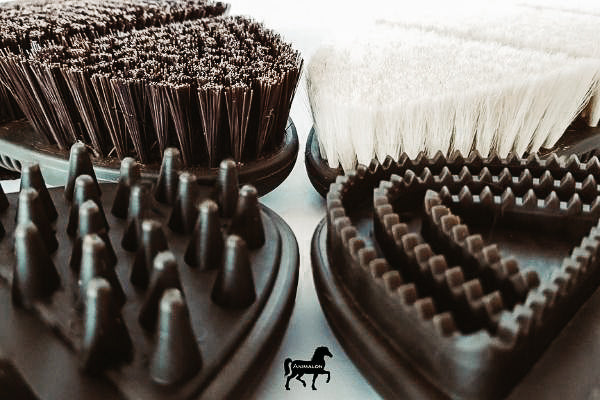
Clean horses properly
Effective cleaning of your horse - How to do it right!
You come to the stable after work/school and your darling looks at you mischievously from the paddock. But all that sparkles are his cheeky, big eyes. The rest is evidence of an extensive rolling bath on the ground. Dust everywhere in the fur, straw/shavings in the mane and, to top it all off, dried dirt crusts on the legs and hooves. Offenstallers in particular know what we're talking about! But there are also candidates among the box and individual paddock horses who know exactly how to get attractive spots. Your mood is already dampened. This not only smells like crap stains, but also like a lot of work. It's no use - you have to get to it! We will show you how you can groom your horse sensibly and effectively. Let's go!
Horse care - how important is it?
If we look at wild horses, you will quickly see that they even groom themselves. Your horse care just looks different. In the wild, cleaning a horse means: being a member of the herd and taking into account the landscape. They pluck entire clumps of hair out of each other's fur. Rub against trees and bushes. Take a sand bath to repel mosquitoes. Cross streams and wet meadows. Rain washes them off and sun dries them again. These are all processes that their metabolically active skin and hooves need to live.
Now your hottie lives in the stable and not on the prairie. We therefore need your help with horse care. Our domesticated horses are sweaty after work (wild horses are known to avoid sweaty action!). Your pores may become clogged. In addition, they tend to move in a limited space. Dust is kicked up. Litter is contaminated in places. Self-care is difficult there. Our “domestic horses” can only live out their innate skin care instinct in places. A level of care is therefore required. This is not just for beauty. Your pet’s health benefits from this. It stimulates blood circulation, prevents insect infestation and stimulates nerve pathways, hair roots and muscle tissue. Brushing a horse makes perfect sense!
Preparatory work. Brushing horse and go!

In order to remove the stubborn incrustations from your friend, you will initially need non-slip cleaning supplies for horses. A stable, yet malleable rubber harrow such as our CareFlex harrow declares war on dirt.
You can easily adjust this to the circumference of your hand. Ideal if the “cleaning session” is expected to last longer. Using circular movements from the neck, work your way back in the direction of the fur towards your shoulder. Depending on how dirty you are, you can do the legs right away or at the end when the torso is finished. Always clean legs from top to bottom! Make sure you adapt the pressure you apply to the brush to the surface! This means that where there are muscles, you can be stronger and in the bony areas (e.g.b Spine, shoulder blade, hips, legs.) should be cleaned more gently. By the way, you will find a detailed video on our Animalon products! Horse care explained via clip - pretty visually helpful!
Our CareFlex massage curry comb also offers you a secure hold as a first tool and supports productive cleaning of your "aardvark". A curry comb to give your horse a pleasant wellness experience at the same time. So always useful for the horse. Whether dirty or not - a relaxing massage every now and then is a treat for every horse. We're not just talking about grooming your horse - your sweetheart benefits from it!
Both rubber harrows are the same to use and you should shake them out at regular intervals. This is the only way to ensure that your partner gets clean and you don't "clean up" dirt again.
To get rid of the worst contamination, a firmer root brush (e.g. b our CareFlex root brush) remedy. Whether it's crusty mud or stuck-on sand - this brush will solve your problem.
You would be interested in our grooming glove. Here you have your horse under control in the truest sense of the word! It can be very effective, especially during the shedding season. Loose hair gets caught in it and is effortlessly removed by the hand as a whole clump. It is well suited for sensitive areas. You can work with it very sensitively. Basically you can use it in the same way as the curry comb. Cleaning, dehairing and massaging at the same time - great job and ideal for grooming the horse properly.
Second strike (you could take it literally!)
Once you have achieved a satisfactory result with your preparatory work, the body brush comes into play. As a dust brush, it removes many deep-seated dust particles from the horse's fur. In our range you will find two recommended variants. The CareFlex brush and the CareFlex horsehair brush. Both have great features! The former is also well suited for more sensitive horses and almost all body parts. The second has dense and medium-soft natural bristles. Horse dust brush = in any case an excellent Animalon solution with great handling features!
When grooming your horse, you take the brush brush in one hand and your curry comb in the other hand. With a regular sweep, you now brush the fur with the new brush in the direction of hair growth. The hand basically follows the direction of the hair from front to back, into the vertebrae, over the neck, back, ribs, stomach and towards the croup down to the legs - everything soft without bumping! The belt position always needs an extra look! Also important: clean the fetlock carefully! A lot of dirt accumulates here. Especially horses with denser coats (e.g.b Tinkers or Friesians) can quickly develop inflammatory symptoms there. From time to time you wipe your tool on the harrow in your other hand. Don't forget: swipe away from you! Brushing your horse doesn't mean getting dirty. Grooming your horse should be fun for you and not turn into more work!
You can get a great finish at the end with the CareFlex shine brush. Even the smallest dust particles are captured by it. What's left is a shimmer that's impressive!
The horse's head and its most sensitive areas are cleaned with a particularly soft curry comb. Our goat hair brush, for example, offers the animal the softest comfort. It gently allows dirt to be pleasantly removed. Forehead, goosenecks and ears etc. - certainly no longer a problem with the soft goat hair of this mild brush. It's a great tip for big cuddlers!
You can carefully clean the eye area and nostrils with a damp baby wipe or handkerchief. A sponge would also work, but it should always be labeled (eyes, nostrils, bottom.) and can be replaced with new ones relatively quickly. Horse care doesn't have to be sterile, but we should pay attention to things like that!
Now you can devote yourself to your pride - your horse's long hair. At the beginning you remove straw and shavings. Often it is enough to shake your tail a little. Your horse's grooming supplies probably include a tail and mane spray, right? Here you are spoiled for choice. From a gentle natural product to glitter effect sprays to a “super emollient” there is everything. In any case, they make brushing much easier for you. Follow the instructions on the bottle and use the product sparingly! After all, your horse’s natural protection should be preserved!
Always use the twist-knee technique for the tail: twist the tail from top to bottom. Place the tail on your knee. Start combing at the very bottom. If it brushes very lightly, you open some of the long hair again. This is how you work your way up to the tail. You will see that significantly less hair is pulled out. The best way to do this is to use our mane and tail brush.

It would be perfect if you took the time every now and then to sort through your partner's tail with your hand (unraveling hair by hair very carefully). This method protects the long hair and makes brushing the horse much easier days later.
The mane is gently combed down from the mane comb towards the ground. Place one hand above your hair to avoid pulling it out.
Taking care of hooves is important!
Cleaning the hooves is just as much a part of horse care as grooming and brushing. Because: Your horse is a running animal and needs four healthy hooves! You can only detect diseases such as thrush at an early stage if you check your hooves every day (when scratching!). This is where our natural-bristle hoof brush and natural-bristle hoof picker can serve you well. Both are comfortable to hold and remove even stubborn dirt from hoofs. A must in your horse grooming kit!
First, carefully scrape out the hoof. It's best to get away from you. This prevents dirt from getting into the fetlock again. Foreign bodies (stones, wood chips) must be carefully removed from the jet grooves. If your horse has horseshoes, check the spaces between them. Then brush the frog and sole thoroughly. You should use the hoof brush to clean the rest of the hoof inside and out. Of course, you can also clean and brush the hooves with water. Finally, you can brush the outside of Hotti's wet hooves with hoof oil or hoof grease. When painted while wet, the natural moisture balance is regulated better! Caring for hooves is the be-all and end-all of your daily work with the horse and this horse care in particular should never be neglected!
Phew, done. with mathematical conclusion
You've noticed that the horse's cleaning supplies can make a significant difference. Different parts of the body require different brushes. Cleaning a horse properly needs to be learned. If your horse closes its eyes in a relaxed manner, lowers its head and stands on three legs to relieve the strain - then you have really done everything right!

Clean horse + happy horse = happy owner.
This calculation works out.
Discover more posts

A good horse has no color, says an old equestrian proverb. Of course, the color of a horse's coat does not influence whether it is suitable for dressage or show jumping or whether the horse ca...
Continue reading
With the start of the grazing season, horse owners are dealing with a vexing issue of horse care: deworming horses. Worms can occur in horses not only in summer, but at all times of the year. ...
Continue reading
